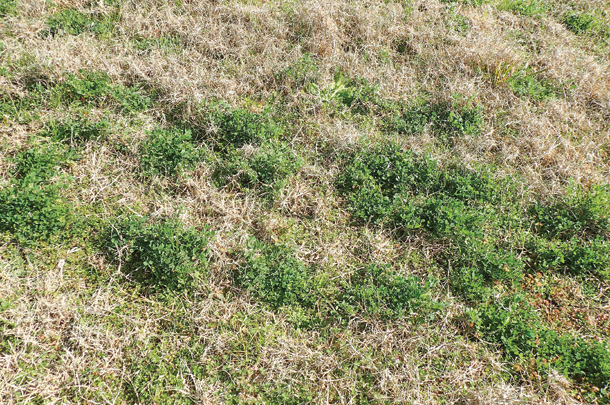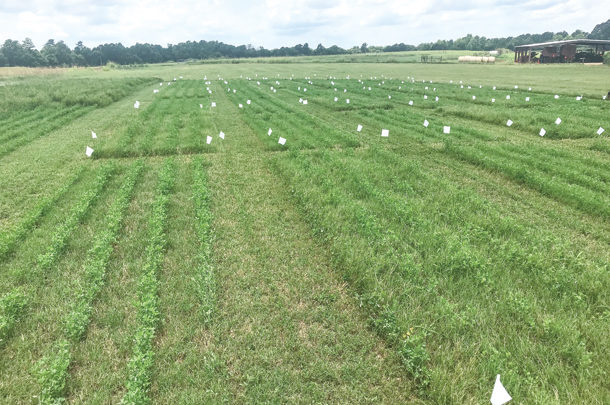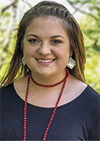Growing a mixture of forages can maximize grazing potential, livestock performance and profitability.
Bermudagrass is one of the most widely grown warm-season perennial grass species in the South, giving producers high yields but only moderate forage quality. Since bermudagrass provides a short grazing season, additional supplementation may be required to meet the nutritional requirements of livestock.
One solution to extend the grazing season and increase forage quality on the existing unit of land is by interseeding with a perennial legume. Alfalfa, also known as the “Queen of Forages,” is a cool-season perennial legume that can provide high yields and high quality while using its unique taproot system to fix nitrogen in the soil. Incorporating a legume, like alfalfa, into existing bermudagrass fields can offer many benefits.
For many producers in the South, interseeding alfalfa into a grass species, like bermudagrass, can extend the grazing season and increase forage yield and quality while reducing cost of applying nitrogen fertilizer. Interseeding legumes and grasses is not a new concept, but there is little information available on grazing and other management recommendations for these mixtures in the South.
Collaborative research among the University of Georgia, Auburn University and the University of Florida is working to develop grazing management recommendations for alfalfa-bermudagrass mixtures. First-year data collection began in 2018 at four locations in Georgia and Alabama; in 2019, additional locations were established in Florida.
At each site, a dual-use alfalfa variety best suited for the location is interseeded into existing hybrid bermudagrass, and researchers evaluate the mixtures for the combined effect of grazing height and frequency. Forage is harvested at 2, 4 or 6 inches every two, four or six weeks. Researchers at each location evaluate stands for forage yield, alfalfa stand density and persistence, forage quality and canopy cover using light reflectance technology.
Following 2018 sampling, plots harvested at 2 and 4 inches every six weeks had the greatest percentage of alfalfa present at Georgia locations. A second year of data collection is necessary to evaluate the effect of these treatments in multiple years and develop best management recommendations for grazing this mixture.
In addition to work at land-grant universities, local producers have begun incorporating alfalfa into their grazing systems. Dan Glenn, owner of Deep Grass Graziers in Fitzgerald, Georgia, uses a multispecies mixture to improve soil health and forage quality while reducing inputs and extending the grazing season. Glenn wanted to include alfalfa into his forage program to obtain the benefits of a forage legume and improve his low-input grass-based livestock system.
In the fall of 2017, Glenn established his first stand of Bulldog 805 alfalfa into an existing stand of Tifton 85 bermudagrass to be used in a rotational grazing system. Once established in the spring of 2018, Glenn harvested the mixture for baleage to use as a high-quality livestock supplement when forages may be limiting.

Once grazing began, Glenn kept grazing height and rest periods in mind. He observed that grazing at a taller height caused bermudagrass to outperform the alfalfa, ultimately causing a decline in alfalfa density through the growing season.
When comparing his grazing experiences with first-year observations in the previously mentioned study, plots harvested at 6 inches also had a visibly lower percentage of alfalfa by the end of the growing season than plots harvested at lower heights. Similar to Glenn’s experience, researchers observed bermudagrass dominance in several plots at the end of the season.
In an effort to manage his second-year stand, Glenn intends to mow the pasture to a lower height to reset the alfalfa and bermudagrass if not sufficiently grazed to allow both forage species to maximize in production. In addition, resetting the pastures will help eliminate any weeds still present from the previous winter. He believes these practices will help with the performance of his mixture.
The first year of managing an alfalfa-bermudagrass mixture came with several learning curves for Glenn. Using a low-input grazing system might have caused some roadblocks, but the benefits of incorporating alfalfa in his mixture outweighed those challenges. Even with stand losses in the first year, he found incorporating alfalfa into the stand of bermudagrass saved approximately 150 units of nitrogen in just one season.
Adding a perennial legume to grass pastures helped him maintain a low-input livestock grazing system by providing natural fertilizer, and his first year stand also allowed him to graze from early spring to late fall, whereas a traditional bermudagrass system provided grazing from June through September. Adding the cool-season perennial filled grazing gaps that may exist with bermudagrass alone.
With the development of Southern-adapted, grazing-tolerant alfalfa varieties, producers in the South have an additional tool to extend the length of grazing, increase yield and quality, and reduce some farm inputs. With the partnership of land-grant universities and local producers, grazing management recommendations will be available soon for others who are ready to mix it up with alfalfa in the South. ![]()
PHOTO 1: Alfalfa and bermudagrass are grown on plots at UGA J. Phil Campbell Sr. Research and Education Center in Watkinsville, Georgia, on June 27, 2018.
PHOTO 2: Deep Grass Graziers’ second-year stand of Bulldog 805 alfalfa was interseeded into Tifton 85 bermudagrass (photo taken in February 2019). Photos provided by Kaylyn Groce.
To learn more about Glenn’s Deep Grass Graziers. For UGA Extension resources related to alfalfa management in the South, visit: Univeristy of Georgia - Forages.
Funding for this project provided by USDA NIFA (2017-70005-27089).











